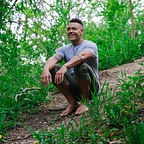Bringing Authenticity Through Flow Movement
HOW DID I GET HERE?
It has taken me a while to remember when I first got into flow movement. The whole practice seems so ”normal” to me now. I had take pause and think on how did I get here?
Looking back, I can see that there were doors that appeared and a decision to walk through them. It’s funny how things come into your life based on circumstance and perception.
For me, it all began with a breaking point. The kind where your realize your job is crushing your soul. It was my second job as a personal trainer, the closest I ever got to working 9–5 in a cubicle. I remember the feeling of the gym walls closing in around me. I remember the faces, the entitled attitudes, the general vibe of discontent in both the staff and the members. What I distinctly remember is that it didn’t feel authentic to me.
My favorite hangout was overrun with the wrong crowd. This was enough to drive me outside to the park and start finding something new for myself. I put my need for structure and goal on hold for play. I didn’t know what I was seeking but I could feel a tiny ember deep inside, gasping for air. As I started to play more and the ember caught fire…and then it all started flowing.
Shortly, there after I made my escape from the fitness cubicle and ventured out on my own as an independent trainer. One winter, I found myself without access to a gym. No more sparkling locker rooms, steam room, or free yoga classes. No squat rack, barbells, boxes, or bars. I had a couple kettlebells, a yoga mat, and a small corner of my apartment’s “fitness center”. By then I was thinking like a kid again which made it easier to get creative and switch up my approach to training.
In this exploration, I used what I had available to me. I considered how the tools I had gathered over the years and they could be used in a different way. I drew inspiration from YouTube videos of traceurs (parkour), martial artists, dancers, gymnasts, and yogis. The dots began to connect and I could see these disciplines as different expressions of natural movement. The practitioners of these disciplines have a unique opportunity to show themselves to the world through their movement artistry.
It’s been a handful of years now since I began to embrace this flow practice. It’s a part I’ve guarded and not taught much. It’s something I am continually crafting. It’s a project that will never be complete but needs no completion.
Don’t get me wrong, I still workout and train with purpose and goals in mind. The flow practice is a way to understand my shortcomings and direct my strengths. The practice keeps me from getting swept away in the bullshit and roots me in my values of acceptance, expression, and creation. On a deep level, flow movement feels like the authentic me.
FLOW AS A PROCESS
More than a style of movement, flow is a psychological state of being. Flow isn’t taught, it emerges as a part of the process. You need only to give yourself permission to get lost in what you love. Adulthood has a way of turning us from clay to stone. There is an accumulation of tension that restricts our being. Flow states dissolve this immobility. We shed what’s unnecessary (mind chatter, doubts, comparisons, negativity) and get back to our authentic selves.
It’s not a prescription or an exact formula. As a coach, I think it’s a beautiful and fascinating process to witness. Movement sparks a small flame which begins to melt the ice. People emerge from behind their masks and lose their fears of being vulnerable. There’s an immersion in joy, a return to childhood. And even though it may be unrefined, it needn’t be critiqued or rushed toward “perfection”. As the practice matures the true meaning of it unfolds to the practitioner.
This particular movement practice is not for everyone, but as you watch you might feel that small fire ignite. If it feels like truth, lean in for more.
Observe, listen, and take the pieces that draw your interest.
Move and practice. Get to know the movement deeply in your body, pay attention to how it feels.
Film yourself. Watch with an eye for details, not judgement.
Find your sticking points and your weak areas. Take this is valuable information and use it to direct your training.
If nothing else, follow the love and enjoy the experience of getting lost in it. It’s not so much how you do it as it is the space to be yourself and what you learn there.
